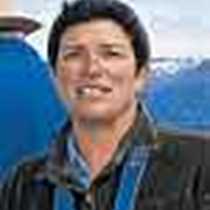Astoria & Cape Disappointment
“I have scarcely experienced a day since our arrival without some novel occurrence or uncommon object.” - Meriwether Lewis
Astoria is one of many ports where large steel bulk carriers and container ships come from around the world to transfer goods to and from trucks and rail cars. The pier where the MV Sea Lion tied up this morning was flanked by old wooden pilings, where historically, large iron or wooden sailing ships, dependent on favorable tides and winds, used to tie up while longshoremen manually moved shipments to and from the ships holds…a very different time indeed.
To further our understanding of the Columbia’s past, we visited the Columbia Maritime Museum. Elaborate displays of Astoria’s fishing and shipping history helped us to better understand the layers of old piers, pilings, and docks scattered along the city’s shore. Astoria has gone through many changes, but still thrives as an important Northwest port.
Later in the morning, we visited another landmark that celebrates Astoria’s historical importance, the Astoria Column. Completed in 1926, the column is adorned with a frieze that weaves together images of the Columbia River’s history. Those of us who climbed all 164 steps were awarded an amazing view of Young’s Bay to the south, the Columbia River to the north, and the mouth of the Columbia to the west.
In the afternoon, the ship sailed west, and we experienced the Columbia Bar first hand as we made our way for Cape Disappointment. In 1788, Captain John Meares, a British explorer, missed the passage over the bar that would lead him into the Columbia River. After realizing he had missed the entrance, he wrote of his disappointment and named the prominent basalt point, Cape Disappointment.
We were far from disappointed during our visit. As the ship headed into Bakers Bay, we passed Cape Disappointment Light standing watch over the confluence of the Pacific Ocean and the Columbia River.
After the MV Sea Lion was secured at Ilwaco Harbor, we made our way up to the Cape Disappointment State Park and Lewis and Clark Interpretive Center. We traveled from the shore into lush temperate rainforest. Tall Sitka spruce, Douglas fir, and western hemlocks towered over us. The heavy fog and rain allows mosses and lichen to thrive in this forest community adding weight and color to large boughs on the trees. With a little imagination and squinting of the eyes, one could imagine what this area must have looked like when the Corp of Discovery arrived here on the Pacific Coast.
“I have scarcely experienced a day since our arrival without some novel occurrence or uncommon object.” - Meriwether Lewis
Astoria is one of many ports where large steel bulk carriers and container ships come from around the world to transfer goods to and from trucks and rail cars. The pier where the MV Sea Lion tied up this morning was flanked by old wooden pilings, where historically, large iron or wooden sailing ships, dependent on favorable tides and winds, used to tie up while longshoremen manually moved shipments to and from the ships holds…a very different time indeed.
To further our understanding of the Columbia’s past, we visited the Columbia Maritime Museum. Elaborate displays of Astoria’s fishing and shipping history helped us to better understand the layers of old piers, pilings, and docks scattered along the city’s shore. Astoria has gone through many changes, but still thrives as an important Northwest port.
Later in the morning, we visited another landmark that celebrates Astoria’s historical importance, the Astoria Column. Completed in 1926, the column is adorned with a frieze that weaves together images of the Columbia River’s history. Those of us who climbed all 164 steps were awarded an amazing view of Young’s Bay to the south, the Columbia River to the north, and the mouth of the Columbia to the west.
In the afternoon, the ship sailed west, and we experienced the Columbia Bar first hand as we made our way for Cape Disappointment. In 1788, Captain John Meares, a British explorer, missed the passage over the bar that would lead him into the Columbia River. After realizing he had missed the entrance, he wrote of his disappointment and named the prominent basalt point, Cape Disappointment.
We were far from disappointed during our visit. As the ship headed into Bakers Bay, we passed Cape Disappointment Light standing watch over the confluence of the Pacific Ocean and the Columbia River.
After the MV Sea Lion was secured at Ilwaco Harbor, we made our way up to the Cape Disappointment State Park and Lewis and Clark Interpretive Center. We traveled from the shore into lush temperate rainforest. Tall Sitka spruce, Douglas fir, and western hemlocks towered over us. The heavy fog and rain allows mosses and lichen to thrive in this forest community adding weight and color to large boughs on the trees. With a little imagination and squinting of the eyes, one could imagine what this area must have looked like when the Corp of Discovery arrived here on the Pacific Coast.




